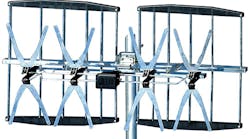This file type includes high-resolution graphics and schematics when applicable.
Energy harvesting plays an important role in gaining higher efficiency for future electronic devices, such as mobile communications equipment and IoT sensors. In search of energy-harvesting solutions, a trio of researchers from the Ricoh Innovations Corp. (Menlo Park, Calif.) proposed an antenna for the purpose of mechanical beamsteering to efficiently capture available RF energy.
By changing the direction of the main beam, maximum power can be harvested without physically rotating the antenna in an attempt for 360-deg. coverage. Their 2 × 2 beamsteered phased-array antenna is tuned by mechanically shifting the position of the feed point, providing a continuous beamsteering angle of ±35 deg. in the E-plane.
The phased-array antenna array is designed for use at S-band, at 2.4 GHz. At that frequency, the size of the array is 0.96 × 0.96 × 0.056 λ. The array features small microstrip patch antenna elements with 19.5% bandwidth. The antenna elements include a U-shaped slot. They are fabricated on commercial RO3010 circuit laminate from Rogers Corp., with a relative dielectric constant of 10.2. The array consists of multiple antenna elements, a feed network panel, and a movable feed structure.
Through simulations, the researchers discovered the optimum center-to-center spacing of the antenna elements for a given space to minimize mutual coupling and maximize gain. By mechanically changing the position of the feeding point, continuous E-plane steering can be accomplished without phase shifters and with low cost for the antenna array.
See “A Mechanically Beam-Steered Phased Array Antenna for Power Harvesting Applications,” IEEE Antennas & Propagation Magazine, Vol. 58, No. 3, June 2016, p. 58.


